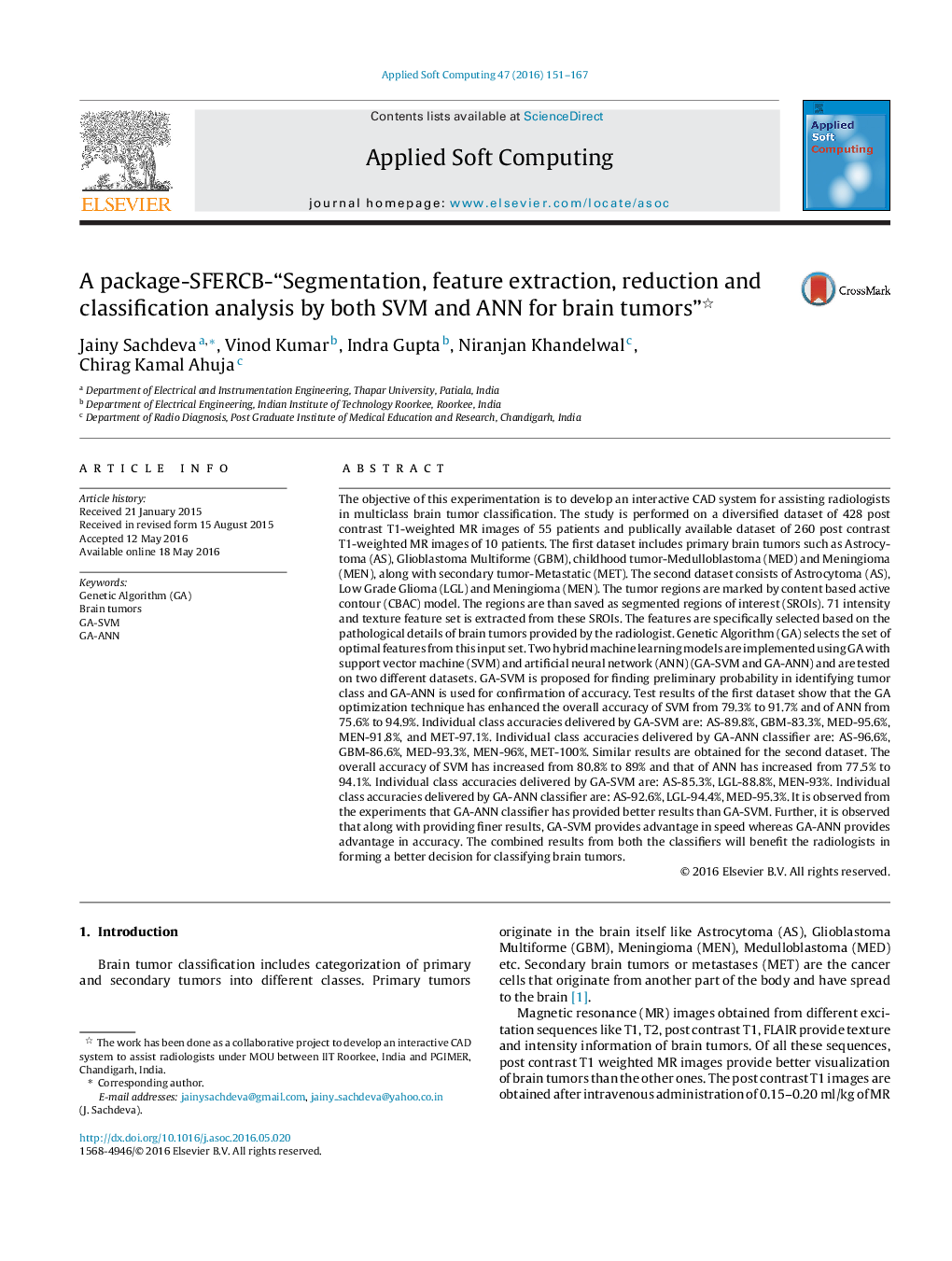| کد مقاله | کد نشریه | سال انتشار | مقاله انگلیسی | نسخه تمام متن |
|---|---|---|---|---|
| 494612 | 862801 | 2016 | 17 صفحه PDF | دانلود رایگان |

• Brain tumors as segmented regions of interests (SROIs) by content based active contour model (CBAC).
• Feature extraction—intensity and texture based features.
• Feature reduction by Genetic Algorithm.
• Classification by Hybrid Models-GA-SVM and GA-ANN.
The objective of this experimentation is to develop an interactive CAD system for assisting radiologists in multiclass brain tumor classification. The study is performed on a diversified dataset of 428 post contrast T1-weighted MR images of 55 patients and publically available dataset of 260 post contrast T1-weighted MR images of 10 patients. The first dataset includes primary brain tumors such as Astrocytoma (AS), Glioblastoma Multiforme (GBM), childhood tumor-Medulloblastoma (MED) and Meningioma (MEN), along with secondary tumor-Metastatic (MET). The second dataset consists of Astrocytoma (AS), Low Grade Glioma (LGL) and Meningioma (MEN). The tumor regions are marked by content based active contour (CBAC) model. The regions are than saved as segmented regions of interest (SROIs). 71 intensity and texture feature set is extracted from these SROIs. The features are specifically selected based on the pathological details of brain tumors provided by the radiologist. Genetic Algorithm (GA) selects the set of optimal features from this input set. Two hybrid machine learning models are implemented using GA with support vector machine (SVM) and artificial neural network (ANN) (GA-SVM and GA-ANN) and are tested on two different datasets. GA-SVM is proposed for finding preliminary probability in identifying tumor class and GA-ANN is used for confirmation of accuracy. Test results of the first dataset show that the GA optimization technique has enhanced the overall accuracy of SVM from 79.3% to 91.7% and of ANN from 75.6% to 94.9%. Individual class accuracies delivered by GA-SVM are: AS-89.8%, GBM-83.3%, MED-95.6%, MEN-91.8%, and MET-97.1%. Individual class accuracies delivered by GA-ANN classifier are: AS-96.6%, GBM-86.6%, MED-93.3%, MEN-96%, MET-100%. Similar results are obtained for the second dataset. The overall accuracy of SVM has increased from 80.8% to 89% and that of ANN has increased from 77.5% to 94.1%. Individual class accuracies delivered by GA-SVM are: AS-85.3%, LGL-88.8%, MEN-93%. Individual class accuracies delivered by GA-ANN classifier are: AS-92.6%, LGL-94.4%, MED-95.3%. It is observed from the experiments that GA-ANN classifier has provided better results than GA-SVM. Further, it is observed that along with providing finer results, GA-SVM provides advantage in speed whereas GA-ANN provides advantage in accuracy. The combined results from both the classifiers will benefit the radiologists in forming a better decision for classifying brain tumors.
An interactive computer aided dignostic (CAD) system for assisting inexperience young radiologists is developed. The difficulty in brain tumors classification is due to similar size, shape, location, hetrogeniety, presence of oedema, cystic and isointense regions has been the key feature of this research. Genetic Algorithm is employed as it is an easy concept and is well understood by radiologists without going in much depth of engineering.Figure optionsDownload as PowerPoint slide
Journal: Applied Soft Computing - Volume 47, October 2016, Pages 151–167